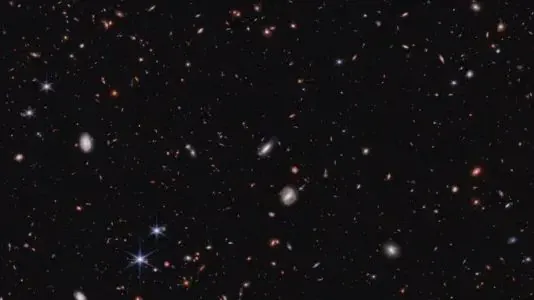
James Webb Space Telescope Challenges Conventional Dark Matter Theories with Surprising Galaxy Discoveries
2024-11-12
Author: Ying
Introduction
In a groundbreaking revelation, astronomers studying data from the James Webb Space Telescope (JWST) have uncovered that some of the universe's oldest galaxies are exhibiting unexpected characteristics. These galaxies appear both larger and brighter than anticipated, indicating they may have formed much earlier and developed at a faster rate than previously thought—potentially without the influence of dark matter.
Research Insights
Research from this team suggests that these findings lend credence to a controversial alternative to dark matter called modified Newtonian dynamics (MOND). Stacy McGaugh, an astrophysicist at Case Western Reserve University, emphasized the discrepancy between observed data and the predictions of dark matter theory, stating, “What the theory of dark matter predicted is not what we see.”
Cosmological Models Reevaluation
The prevailing cosmological model has traditionally posited a gradual hierarchical evolution of galaxies influenced by cold dark matter. This model has provided a framework for understanding the varying shapes and sizes of galaxies scattered throughout the universe. However, the JWST has yet to detect the faint signals theorized to arise from the tiny, primitive building blocks of these galaxies from the early universe. Instead, researchers observed that the early galaxies were significantly larger and brighter than expected, raising questions about the validity of current theories.
Aligning with MOND Predictions
What's even more fascinating is that this rapid growth aligns with MOND's predictions made 26 years ago. McGaugh expressed satisfaction with the findings, remarking, “I was raised to think that saying ‘I told you so’ was rude, but that's the whole point of the scientific method: Make predictions and then check which come true.”
Alternative Explanations
While it’s possible that some of the bright signals detected by the JWST correspond to active supermassive black holes rather than galaxies, this scenario merely shifts the mystery from the emergence of early stars to an abundance of early supermassive black holes, which adds another layer to the enigma.
Background on MOND
MOND was first proposed by Israeli physicist Mordehai Milgrom in 1982 as a means to explain the unexpectedly fast rotation of galaxies without the need for dark matter. It posits that under extremely weak gravitational conditions, such as at the edges of galaxies, gravity does not behave in accordance with Newtonian predictions. Despite its successes, MOND faces criticism from some astronomers who find it difficult to fit into a unified theory that could encompass various cosmological observations.
Contrast with Dark Matter Theory
In contrast, while the dark matter theory can account for many observations, it struggles to explain some phenomena that MOND addresses efficiently. As a result, researchers find themselves at a crossroads between these conflicting theories, with neither providing a comprehensive solution to the mysteries of the universe.
Ongoing Struggle in Cosmology
This dichotomy highlights the ongoing struggle in cosmology. We're caught between two theories that seem irreconcilable despite their applications to closely linked yet distinct evidence,
Conclusions and Future Directions
Though MOND is not widely accepted in the cosmological community, the team believes its string of successful predictions could indicate that it holds pivotal insights about the universe. They concluded, “It must be telling us something, but what that is remains as mysterious as the nature of dark matter itself.”
As scientists continue to analyze the burgeoning data from JWST, the dialogue surrounding dark matter and alternative theories like MOND is likely to intensify, challenging our understanding of the cosmos and its fundamental components. Stay tuned as we uncover more secrets of the universe through the lens of one of the most advanced telescopes ever built!



 Brasil (PT)
Brasil (PT)
 Canada (EN)
Canada (EN)
 Chile (ES)
Chile (ES)
 España (ES)
España (ES)
 France (FR)
France (FR)
 Hong Kong (EN)
Hong Kong (EN)
 Italia (IT)
Italia (IT)
 日本 (JA)
日本 (JA)
 Magyarország (HU)
Magyarország (HU)
 Norge (NO)
Norge (NO)
 Polska (PL)
Polska (PL)
 Schweiz (DE)
Schweiz (DE)
 Singapore (EN)
Singapore (EN)
 Sverige (SV)
Sverige (SV)
 Suomi (FI)
Suomi (FI)
 Türkiye (TR)
Türkiye (TR)